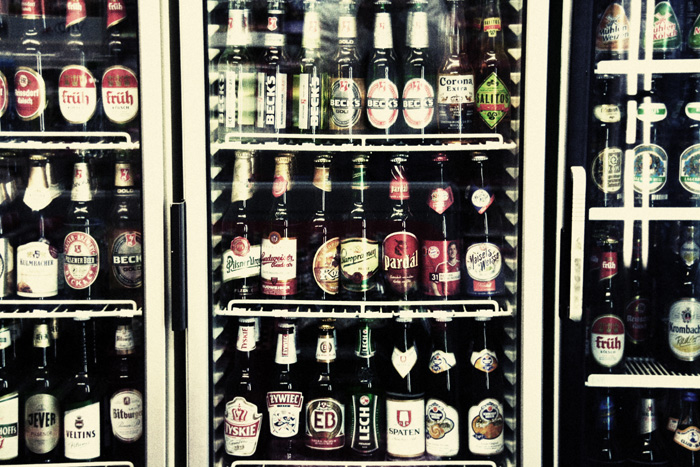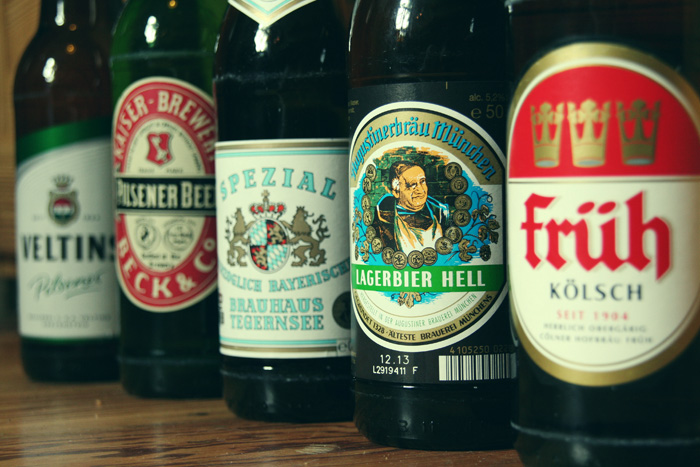
「ドイツビールって美味しいんでしょう?」
これまで何度となく耳にした問い。秋でもないのにオクトーバーフェストが日本各地で大盛り上がりの昨今、日本ではドイツビール人気がメキメキ上昇中であるというのに、ビール嫌いでワイン党の私はドイツビールを一切味わったことがなかった。ドイツ暮らし3年が過ぎ去った今、“人生損しているのでは?”と思い直して一念発起。知られざるドイツビールの実態を調べ、いざビールと向き合うことにした。
銘柄数5000以上!
2012年のデータによるとドイツ国民一人当たりのビール年間消費量は107.6リットル。水が年間一人当たり約135リットル、コーヒーが約153リットルという数字と比べると、ビール消費量が半端ではないことは瞭然。だがドイツの一人当たり消費量は世界2位で、ドイツ人を制したのはチェコ人の年間一人当たり132リットルという消費量。ちなみに日本人は一人当たり約45リットル。チェコ人に首位を奪われたとはいえ世界で最多の1339の醸造所がしのぎを削り、5000以上の銘柄が製造されているビール天国ドイツ。毎日違う銘柄を1種類ずつ試して全部制覇するならば、実に13年以上を要することになるのだ。ドイツではビール、ワインの飲酒・購入が16歳から法的に認められているし、数字に見るビールのパワーに圧倒されてしまう。
ビールは最古の法律?
北ヨーロッパでは古代ゲルマン人が定住生活に入った紀元前1800年頃に原始的なビールを愛飲していた記録が残っているが、今日のドイツビール史が本格的に軌道に乗ったのは、大のビール好きだったフランク王国のカール大帝が西ローマ帝国を再興した8世紀頃から。時は流れ1516年、時のバイエルン侯ヴィルヘルム4世が制定した「ビール純粋令」が、ドイツビールの運命を決めた。これは「ビールは大麦、ホップ、水のみを原料とする」という掟を定めた、今なお効力を持つ食品にまつわる世界最古の法律である。16世紀当時のビールは麦芽、ホップ、水の主要原料のほか香草、香辛料、果実が用いられ粗悪品が横行していたため、品質向上と小麦やライ麦の使用制限を目的に発令されたという。ドイツ全土にわたって長らく継承されてきたが、最近では1993年の酒税法改正により国内で醸造・消費される一部のビールにも、大麦以外の麦芽や砂糖を使うことが可能に。それでは法律改正でドイツビールの味は変わったのだろうか? 答えはNo。ドイツ国内の醸造所の多くは頑固一徹に従来のビール純粋令を守り抜いているという。なぜドイツ人がここまでビールにプライドを持っているのか、これまで謎に感じていたのだが、なるほど“歴史+法律+職人気質”というドイツ人が愛してやまない要素が三位一体となった代物なのだと合点がいった。そうして純粋令を謳う一文がラベルに貼られたビールは、過去から現在、未来へと国民に愛され続けるのだ。
ビールはスピリチュアル系?
8世紀、前述のカール大帝は住民たちをキリスト教に改宗させ、支配拠点として修道院を各地に建設。何と修道院にはビールの醸造所が併設されていた。大帝はビールをこよなく愛し、ゲルマン人の誇るべき酒としてビールの地位を復権させた。12世紀になると、大勢の巡礼者や物乞いをもてなすために修道院で大量のビールが醸造されるようになり、やがて研究熱心な修道僧たちはビール醸造技術を高めていき修道院ビールは市民にも人気沸騰。ビール作りが修道院の財政をも潤すようになったというから面白い。さらに興味深いのは、中世の修道士たちが断食期間にビールを飲んでいたという史実。教会の古文書に「液体を摂取することは断食に違反しない」という文献を発見したのをはじまりに、“液体のパン”である栄養満点のビールで苦行を乗り越えていたとか。悪酔いして修行どころじゃないのではと不審に思ったところ、飲み過ぎる僧侶を罰するために「吐くほどに飲んだ修道僧には30日間の苦行を課す」などの厳しい戒律もあったそう。
歴史とデータを学んでイメージトレーニング出来たので、そろそろブラウハウス(醸造所兼レストラン)へ繰り出そうとしたところ、ドイツ人の家人に足止めを食らった。ビールスタイルと種類を予習しないと楽しめないのだという。少々面倒臭いほどに誇り高きドイツ人気質にならい、さらに勉強は続く。
大きくは醸造方法の違いによって「上面発酵(エール)」と「下面発酵(ラガー)」の2種に分類されるビールのスタイル。上面発酵は大麦麦芽を使用し、サッカロマイセス・セルビシエという出芽酵母を用い、15℃〜20℃の常温で短期間で発酵させる伝統的な作り方。一方の下面発酵は原料に麦芽を使用してサッカロマイセス・カールスベルゲンシスという酵母を用い、10℃以下の低温で熟成させながら比較的長時間の発酵を行う近代的製法。前者は最終的に酵母が浮かび上面で層を作るので上面発酵、後者は酵母が沈みこむので下面発酵と呼ばれる。
エール vs ラガー。さて味はどう違うのか、さっぱり想像できない自分。家人に連れられて、ケルンの地ビール「ケルシュ」を味わいに最寄りのブラウハウスへ出かけた。

たった200mlの黄金色に輝く小さなタンブラーグラス。値段は1.5ユーロ。上面発酵のケルシュはほのかに甘くフルーティで、ビール初心者の私にも飲みやすい。炭酸が少なく泡をすぐに逃さないために、この細い円柱のグラスで供されるそうだ。飲み終えるとクランツと呼ばれる王冠のような形をした手提げのお盆に載せて、グラスが次々に運ばれてくる。新しいグラスに交換すると、コースターに線が1本引かれる。線の数が伝票代わりとなる明朗会計のシステムは、実用性重視で何ともドイツ的だ。
主要なビールの種類といえば、一番人気は50%以上の市場シェアを誇る下面発酵の「ピルスナー」。ホップの苦みと爽快なノド越しで知られる。ほかに、南ドイツで支持される小麦から作られた上面発酵の白ビール「ヴァイツェン」、ミュンヘンで発祥し、甘みがあり鮮やかなゴールド色を持つことから“明るい”という名を冠した下面発酵の「ヘレス」、下面発酵でホップの苦みと深い色が特徴的なドルトムント工業地域で発祥の「ドルトムンダー・エクスポート」、デュッセルドルフ名物でもあり上面発酵の一種で木樽熟成された、比較的苦いダークビールの「アルトビール」、ザクセン州を中心に人気が高く文豪ゲーテも愛したという黒ビール「シュヴァルツビア」、白ビール系の酸味のあるエールに赤か緑色のシロップを加えたベルリン名物の「ベルリナーヴァイセ」、そして前述の「ケルシュ」。

(写真は左から2本がビルスナー、続いて2本がヘレス、右がケルシュ)
かつてドイツの醸造業界では、一日単位または週単位で給与の一部はビールで支払われていたという。驚くなかれ今日にもこの伝統は継承されていて、多くの醸造所の労働者たちは月に40〜100リットルものビールを給与の一部として受け取っているのだとか。ドイツビール講座入門をひとしきり終えて、ドイツビールを飲むことは“伝統を飲む”という行為なのだと気づく。生活のごく身近に全国民が時代を超えて愛する品があるのは、妙にうらやましい気がする。古代ギリシアの哲学家プラトンが「ビールの発明者は賢人だ」と夢中になり、18世紀アメリカの政治家であり物理学者のベンジャミン・フランクリンをして「ワインの中には英知がある。ビールの中には自由がある。水の中には細菌がある」と言わせしめたビールの存在。人類の歴史の裏に、文化の影にビールがある。私の日常で始まったばかりの2013年ビールの旅。祝いの席で飲み、落ち込んでは景気付けに飲み、何はなくともとりあえずビール……と生粋のドイツ人のようにはいかないだろうが、その伝統を堪能できる幸運にまずは乾杯しよう。厳かな心持ちでドイツビールがたどった歴史に思いを馳せながら、ケルシュのグラスを生まれて初めて飲み干した。
“German beer is great, isn’t it?”
I’ve heard this question so many times now. In recent years Oktoberfests are happening everywhere in Japan (despite it not being autumn usually), and the popularity of German beers is on the rise. I am more of a wine person and tend to avoid beer, but having spent the last three years living in Germany without indulging much in the latter, I’ve come to think that I may be missing out on something in life after all. So I set out to research the current state of all things beer in Germany, facing the unknown head on.
There are 5,000 different types!
According to 2012 data, the annual consumption of beer in Germany adds up to 107.6 liters per person. Compared to water at about 135 liters per person and coffee at about 153 liters per person annually, it’s obvious that beer consumption is no joke. Only the Czech surpass the Germans, downing a whopping 132 liters per person annually. By comparison, the Japanese only consume a modest 45 liters per person per year. There was a time in Germany when its annual per capita consumption exceeded 140 liters, but it has decreased since the 1970s. Even though the Czechs stole first place, competition among breweries in Germany is fiercely competitive – there are 1339 of them, more than in any other country – and, with over 5,000 labels being sold, the country is heaven for the beer enthusiast. If you tried a different kind one each day, it would take you more than 13 years to try them all. German law permits the purchase and consumption of alcohol from the age of 16. Even just measured by the numbers, the power of beer is mindblowing.
Beer: the oldest food and drink law?
In Northern Europe, records of Germanic settlers drinking primitive beer can be found as far back as 1800 B.C. The history of modern German beer basically starts in the 8th century, when the beer-loving Charlemagne, king of the Franks, was rebuilding the Western Roman empire. Skip ahead to 1516 to the time of the Reinheitsgebot, enacted by William V, which had a huge impact on the beer culture in Germany: One of the oldest laws governing food and drink still in force in the world today, in its original form it stated that the only ingredients for beer must be water, barley and hops. It was issued for two reasons: to restrict the use of rye and wheats, in order to make sure the bakers didn’t run out of ingredients to make bread, and to exclude other ingredients, such as sweet herbs, spices and fruit juices, in order to improve beer quality generally. The Reinheitsgebot was extended to all of Germany and existed in various iterations for a long time. Only quite recently, with the 1993 Liquor Tax Act Reform, the use of malt and sugars other than barley became possible for selected domestically brewed and consumed beers. So, has the taste of beer changed with the reforms? The answer is: No. The majority of breweries in Germany stick to the ancient law with the tenacity of a bulldog. It had always been a mystery to me why Germans were this proud of their beer. It started to dawn on me that respect for history, law and artisanality are important ingredients of the Germans’ infatuation with the drink. Beers with a label advocating the law continue to be loved by the people.
Beer: spiritual?
In the 8th century, Charlemagne started to convert the people to Christianity and constructed monasteries everywhere. And many of them featured a beer brewery. He deeply loved beer and reinstated beer as an alcoholic beverage the Germanic people could be proud of. In the 12th century, the monasteries brewed large quantities of beer to entertain the many pilgrims and beggars passing through. Before long, the committed monks starting improving their beer brewing techniques, and monastery beers became wildly popular among the people. Fascinatingly enough, beer making came to strongly benefit the monasteries’ coffers. Of particular interest is the fact that the medieval monks themselves drank beer while fasting. Starting with a flexible interpretation of scripture stating that “consuming liquids does not violate the fast”, it was established that one could practice asceticism while still drinking beer, the nutritious “liquid bread”. Monks who tended to too indulge too much were suspected of being slaves to alcohol and not fit for monasticism. Thus, there were strict commandments for a 30-day penance for monks who drank so much they got sick.
I had learned my facts and history and prepared myself mentally, but when I was about to head down to the Brauhaus (brewery and restaurant), my German in-laws told me I should first research the types and styles of beers in order to be able to fully enjoy them. Following their lead, I continued my studies.
Principally, the styles of beers can be divided into two types based on the way they are brewed: “top-fermenting (ale)” and “bottom-fermenting (lager)”. Top-fermentation uses malted barley and a budding yeast called “Saccharomyces cerevisiae”, fermenting for a short period of time, at about 68ºF. The bottom-fermenting process, on the other hand, works with malt and “Saccharomyces carlsbergensis” yeast, which matures for a relatively long time at colder tempuratures below 50ºF. In ales, the yeast rises to the top and creates a head, hence the term ‘top-fermenting’, while in lagers, the yeast sinks to the bottom during fermentation. I couldn’t have imagined how different they taste. My family first took me out to the neighborhood Brauhaus (brewhouse) to taste Kölsch, Cologne’s local beer.
(From left: 2 glasses of Pilsner, 2 glasses of Helles, and Kölsch)
Being served in a small tumbler holding only 200ml and costing not more than 1.50 Euro, the golden, top-fermented Kölsch was easy to drink for a beer newbie like myself, tasting vaguely fruity and sweet. Because Kölsch loses carbonic acid really fast, it’s provided in long, narrow cylindrical glasses that don’t let the bubbles escape so easily.
There are many other types: The bottom-fermented, strongly hoppy “Pilsner”, which boasts more than 50% market share. The top-fermented “Weizen” made with wheat popular in Southern Germany, and the bottom-fermented “Helles” named after the German word for “bright” because of its bright gold color, originating in Munich. Further North, you will find the similar, but somewhat heavier, bottom-fermented “Export” from the industrial area around the city of Dortmund, with its characteristic deep golden color and bitter hops taste and the famous, comparatively bitter dark “Altbier” from Düsseldorf, which is matured in wooden barrels. In Eastern Germany, you will find the dark “Schwarzbier” primarily popular in Saxony and loved by the great literary figure Goethe in his day, as well as the white, acidic ale popular in the capital, called “Berliner Weisse” to which red or green fruit syrup is added just before drinking.
(From left: 2 glasses of Pilsner, 2 glasses of Helles and Kölsch on the right)
In former times, brewery workers in Germany received part of their paycheck in beer on a daily or weekly basis. Lo and behold, this tradition continues even today, as many brewery employees take home as much as 40-100 liters for free each month. The ancient Greek philosopher Plato stated that the inventors of beer were geniuses. The American politician and physicist Benjamin Franklin said, “in wine there is wisdom, in beer there is freedom, in water there is bacteria.” In the history of humanity and the evolution of culture through the ages, beer has played a role for longer than most of us can picture. While contemplating the history of German beer, I downed my first glass of Kölsch.
 たった200mlの黄金色に輝く小さなタンブラーグラス。値段は1.5ユーロ。上面発酵のケルシュはほのかに甘くフルーティで、ビール初心者の私にも飲みやすい。炭酸が少なく泡をすぐに逃さないために、この細い円柱のグラスで供されるそうだ。飲み終えるとクランツと呼ばれる王冠のような形をした手提げのお盆に載せて、グラスが次々に運ばれてくる。新しいグラスに交換すると、コースターに線が1本引かれる。線の数が伝票代わりとなる明朗会計のシステムは、実用性重視で何ともドイツ的だ。
主要なビールの種類といえば、一番人気は50%以上の市場シェアを誇る下面発酵の「ピルスナー」。ホップの苦みと爽快なノド越しで知られる。ほかに、南ドイツで支持される小麦から作られた上面発酵の白ビール「ヴァイツェン」、ミュンヘンで発祥し、甘みがあり鮮やかなゴールド色を持つことから“明るい”という名を冠した下面発酵の「ヘレス」、下面発酵でホップの苦みと深い色が特徴的なドルトムント工業地域で発祥の「ドルトムンダー・エクスポート」、デュッセルドルフ名物でもあり上面発酵の一種で木樽熟成された、比較的苦いダークビールの「アルトビール」、ザクセン州を中心に人気が高く文豪ゲーテも愛したという黒ビール「シュヴァルツビア」、白ビール系の酸味のあるエールに赤か緑色のシロップを加えたベルリン名物の「ベルリナーヴァイセ」、そして前述の「ケルシュ」。
たった200mlの黄金色に輝く小さなタンブラーグラス。値段は1.5ユーロ。上面発酵のケルシュはほのかに甘くフルーティで、ビール初心者の私にも飲みやすい。炭酸が少なく泡をすぐに逃さないために、この細い円柱のグラスで供されるそうだ。飲み終えるとクランツと呼ばれる王冠のような形をした手提げのお盆に載せて、グラスが次々に運ばれてくる。新しいグラスに交換すると、コースターに線が1本引かれる。線の数が伝票代わりとなる明朗会計のシステムは、実用性重視で何ともドイツ的だ。
主要なビールの種類といえば、一番人気は50%以上の市場シェアを誇る下面発酵の「ピルスナー」。ホップの苦みと爽快なノド越しで知られる。ほかに、南ドイツで支持される小麦から作られた上面発酵の白ビール「ヴァイツェン」、ミュンヘンで発祥し、甘みがあり鮮やかなゴールド色を持つことから“明るい”という名を冠した下面発酵の「ヘレス」、下面発酵でホップの苦みと深い色が特徴的なドルトムント工業地域で発祥の「ドルトムンダー・エクスポート」、デュッセルドルフ名物でもあり上面発酵の一種で木樽熟成された、比較的苦いダークビールの「アルトビール」、ザクセン州を中心に人気が高く文豪ゲーテも愛したという黒ビール「シュヴァルツビア」、白ビール系の酸味のあるエールに赤か緑色のシロップを加えたベルリン名物の「ベルリナーヴァイセ」、そして前述の「ケルシュ」。
 (写真は左から2本がビルスナー、続いて2本がヘレス、右がケルシュ)
かつてドイツの醸造業界では、一日単位または週単位で給与の一部はビールで支払われていたという。驚くなかれ今日にもこの伝統は継承されていて、多くの醸造所の労働者たちは月に40〜100リットルものビールを給与の一部として受け取っているのだとか。ドイツビール講座入門をひとしきり終えて、ドイツビールを飲むことは“伝統を飲む”という行為なのだと気づく。生活のごく身近に全国民が時代を超えて愛する品があるのは、妙にうらやましい気がする。古代ギリシアの哲学家プラトンが「ビールの発明者は賢人だ」と夢中になり、18世紀アメリカの政治家であり物理学者のベンジャミン・フランクリンをして「ワインの中には英知がある。ビールの中には自由がある。水の中には細菌がある」と言わせしめたビールの存在。人類の歴史の裏に、文化の影にビールがある。私の日常で始まったばかりの2013年ビールの旅。祝いの席で飲み、落ち込んでは景気付けに飲み、何はなくともとりあえずビール……と生粋のドイツ人のようにはいかないだろうが、その伝統を堪能できる幸運にまずは乾杯しよう。厳かな心持ちでドイツビールがたどった歴史に思いを馳せながら、ケルシュのグラスを生まれて初めて飲み干した。
(写真は左から2本がビルスナー、続いて2本がヘレス、右がケルシュ)
かつてドイツの醸造業界では、一日単位または週単位で給与の一部はビールで支払われていたという。驚くなかれ今日にもこの伝統は継承されていて、多くの醸造所の労働者たちは月に40〜100リットルものビールを給与の一部として受け取っているのだとか。ドイツビール講座入門をひとしきり終えて、ドイツビールを飲むことは“伝統を飲む”という行為なのだと気づく。生活のごく身近に全国民が時代を超えて愛する品があるのは、妙にうらやましい気がする。古代ギリシアの哲学家プラトンが「ビールの発明者は賢人だ」と夢中になり、18世紀アメリカの政治家であり物理学者のベンジャミン・フランクリンをして「ワインの中には英知がある。ビールの中には自由がある。水の中には細菌がある」と言わせしめたビールの存在。人類の歴史の裏に、文化の影にビールがある。私の日常で始まったばかりの2013年ビールの旅。祝いの席で飲み、落ち込んでは景気付けに飲み、何はなくともとりあえずビール……と生粋のドイツ人のようにはいかないだろうが、その伝統を堪能できる幸運にまずは乾杯しよう。厳かな心持ちでドイツビールがたどった歴史に思いを馳せながら、ケルシュのグラスを生まれて初めて飲み干した。









